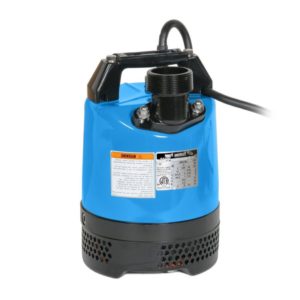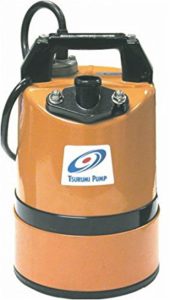 If you need to move water against gravity, you’re going to need a utility pump. If that water needs to be moved for recreational purposes (e.g., for fish ponds, waterfalls, and fountains) or to preserve property (e.g., for flood control after hurricanes or flash floods), you’ll need a dewatering pump.
If you need to move water against gravity, you’re going to need a utility pump. If that water needs to be moved for recreational purposes (e.g., for fish ponds, waterfalls, and fountains) or to preserve property (e.g., for flood control after hurricanes or flash floods), you’ll need a dewatering pump.
If you need water absolutely gone, you’ll want to go beyond a regular drainage pump to a full on low level residue pump like the Tsurumi LSC1.45-61. But if you don’t need water completely cleared down to the last few millimeters and simply want a lot of it gone quickly, there are cheaper options on the market.
This is where the Tsurumi LB-480-62 Compact Submersible Dewatering Pump comes into play. At just over $300, it’s one of the most cost-effective compact dewatering pumps you can buy. Is it worth it? We certainly think so. You can read our full review below, and you can buy it here. If you’d like the automatic version, the LB-480A-62, you can buy it here for about $100 more.
Key Features of the Tsurumi LB-480-62 Dewatering Pump (60 Second Summary)
 The Tsurumi LB-480-62 is a manual electric submersible dewatering pump. Designed for both indoor and outdoor use, it’s an electric utility pump purposed for water drainage and water removal without sump pumps. It uses a 2/3 HP, single phase, thermally protected 110 volt, 5.9 amp motor with a maximum flow rate of 3,744 gallons per hour, or 62.4 gallons per minute with a max head attained at 39.5 feet. Water removal drops to 3,000 GPH at 15 feet, 600 GPH at 35 feet, and shut-off occurs at 39.5 feet. It is capable of removing water down to 4 inches (101.6 mm) above a flat surface and has a minimum continuous running water level of 2 inches. The pump is 7-11/16 inches in diameter and 11-1/4 inches tall while weighing 28 pounds. The power cable is 32 feet long. The pump carries the standard 2 year Tsurumi warranty.
The Tsurumi LB-480-62 is a manual electric submersible dewatering pump. Designed for both indoor and outdoor use, it’s an electric utility pump purposed for water drainage and water removal without sump pumps. It uses a 2/3 HP, single phase, thermally protected 110 volt, 5.9 amp motor with a maximum flow rate of 3,744 gallons per hour, or 62.4 gallons per minute with a max head attained at 39.5 feet. Water removal drops to 3,000 GPH at 15 feet, 600 GPH at 35 feet, and shut-off occurs at 39.5 feet. It is capable of removing water down to 4 inches (101.6 mm) above a flat surface and has a minimum continuous running water level of 2 inches. The pump is 7-11/16 inches in diameter and 11-1/4 inches tall while weighing 28 pounds. The power cable is 32 feet long. The pump carries the standard 2 year Tsurumi warranty.
The LB-480-62 has a 2 inch top discharge and requires a standard 2 inch hose (e.g., a PVC discharge hose); it will not be compatible out of the box with a standard garden hose, although it can be adapted to fit one. It is capable of fitting inside an 8 inch pipe or enclosure and uses a semi-vortex pump design that provides additional longevity even if the internal impeller degrades over time.
How Does the Tsurumi LB-480-62 Compare to the LB-480A-62 and Other Dewatering Pumps?
 Because the LB-480-62 is narrow enough to fit into an 8 inch pipe, it’s a lot cheaper than many deep or dewatering pumps on the market that need much larger (and expensive) piping for internal installations.
Because the LB-480-62 is narrow enough to fit into an 8 inch pipe, it’s a lot cheaper than many deep or dewatering pumps on the market that need much larger (and expensive) piping for internal installations.
The LB-480-62, like most dewatering pumps, is manual. For automatic operation, it will require either an automatic float switch (we share recommended models below) or an upgrade to the automatic model, the LB-480A-62. This is the main difference between the 480A and the regular 480; the 480A includes an automatic float switch and can be used fully automatically. The float switch uses internal electric sensors to determine the water level. As a result, in contrast to mechanical float switches, it will not malfunction due to physical obstruction or entrapment by debris. The automatic version is also slightly too large to fit inside an 8 inch pipe due to the float switch.
Compared to the Tsurumi LSC, both pumps can be used for residential, commercial, and industrial site drainage and waste water drainage, in addition to work related to decorative waterfalls and fountains and sediment removal from small basins and sumps. The primary differences are in speed, head, and minimum draining heights. The LSC is slower (2,700 GPH vs 3,744 GPH) but pumps to a slightly greater max head (40 feet vs 39.5 feet) and drains much, much lower (to 1 mm of surface vs to 101.6 mm, or to 1/25 inches vs to 4 inches).
Our Short and Long Term Experiences Installing and Using the Tsurumi LB-480-62 Submersible Pump
 We’ve seen these pumps used in a range of applications. One client used four to pump water roughly 30 feet uphill from her 15,000 gallon koi pond in order to power a stream and waterfall 24 hours a day, 7 days a week, and 365 days a year. She noted one failed in about 2 years while the others were still going 5 years later. We’ve also seen many working hard after years of misuse in rental fleets, and the fact that they show up so frequently in such demanding settings says a lot about their durability.
We’ve seen these pumps used in a range of applications. One client used four to pump water roughly 30 feet uphill from her 15,000 gallon koi pond in order to power a stream and waterfall 24 hours a day, 7 days a week, and 365 days a year. She noted one failed in about 2 years while the others were still going 5 years later. We’ve also seen many working hard after years of misuse in rental fleets, and the fact that they show up so frequently in such demanding settings says a lot about their durability.
The pump is also an impressive performer when defending property. In recent years we’ve seen them used to combat extreme flooding conditions, such as with Hurricane Katrina, Harvey, Irene, Irma, Super Storm Sandy, and more. To put it simply, if you need to get water out of your house or home as quickly as possible and can’t or don’t want to spend time trying to get a gas-powered pump to cooperate, a good dewatering pump like the LB-480-62 is what you need for your residence or commercial building. If you’re in a flood-prone zone, you already know you need a good sump pump (e.g., the Zoeller M267 for an AC pump or the Basepumps CB1500 for a water-based pump) on the preventative end. On the responsive end, a good dewaterer can be just as important.
Remember that you’ll need to watch the pump whenever it’s running to make sure it doesn’t run dry; if you don’t want to do this, you’ll want to either buy the upgraded model, the LB-480A, which includes a float switch and automatic operation, or buy a utility pump controller like the HydroCheck HC7000 or HydroCheck HC6000 for indoor use or the HydroCheck HC6100 for outdoor use. Although the motor includes thermal shutoff protection from overloading and accidental run-dry situations, if the pump runs dry, it will still prematurely wear the motor and internal components.
Troubleshooting and Installation Tips to Get Your Tsurumi LB-480-62 Working Sooner
The primary problem we tend to see with these involves the undersized intake holes; if you use the pump in anything besides clean water, you’re going to need to clean it frequently (perhaps weekly) to clear away things like tree seeds, pine needles, algae, or whatever is endemic to your local environment. If you don’t clear the intake holes, water flow will slow dramatically.
Besides clogging issues, there’s not really any maintenance to speak of. We’re also fans of the ability to adjust the fitting on the discharge hose. Sometimes it’s the little things that make all the difference. It’s worth mentioning that you might notice a slight increase in your electric bill if you run the pump all day, every day. This is an unfortunate consequence of any electric motor; it’s still much cheaper than gasoline.
As noted above, it’s important to remember that you’re going to need an accessory float switch (e.g., a utility pump controller) if you want to be able to drain water without babysitting the pump. We recommend either HydroCheck HC7000 or HydroCheck HC6000 for indoor use or the HydroCheck HC6100 for outdoor use. Each of these controllers can be used with pumps delivering up to 3/4 horsepower and drawing up to 14 amps, meaning they’ll be compatible in power needs with the Tsurumi and capable of controlling it automatically. Remember that you’ll additionally need a 2 inch discharge hose to connect to the pump.
Tsurumi LB-480-62 Pump Pros, Cons, and Value Comparison
In conclusion, if you need to move water for recreational or property-defending purposes, you need a good dewatering pump, and the Tsurumi LB-480-62 is one of the best you’re likely to find under $400. It’s not the cheapest dewatering pump out there, but it’ll keep going long after cheaper ones have failed, and it will do so without needing costly repairs. Remember that it won’t drain down to 1 mm like the Tsurumi LSC, so if you need water completely gone, that’s the pump to buy instead. However, if you’re primarily interested in moving and removing water rather than in eliminating it, the LB-480 series will work very well.
Our main suggestion would be to either connect it to an automatic utility pump switch so you won’t need to monitor it whenever it’s running or buy its automatic equivalent, the LB-480A-62; the advantage of choosing the 480A over a separate float switch is that you’ll never have warranty concerns over float switch compatibility. Beyond that, you’ll also have greater reliability since the switch was built from the ground up by Tsurumi to control the 480A.
You can buy the Tsurumi LB-480-62 here on Amazon. You can buy the Tsurumi LB-480A-62 here. You can buy the Tsurumi LSC here. You can buy the HydroCheck HC7000 here. You can buy the HydroCheck HC6000 here. You can buy the HydroCheck HC6100 here. You can buy a 2 inch PVC discharge hose here.
If you find our work at PumpThatSump helpful, you can support our relentless reviewing of every sump pump on the market by shopping via our Amazon link for whatever you need to make your house a home. Despite being self-employed, we promise not to spend it all on health insurance.




